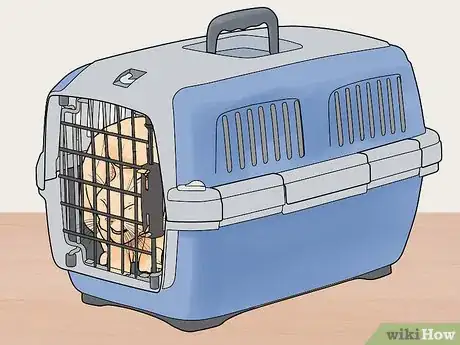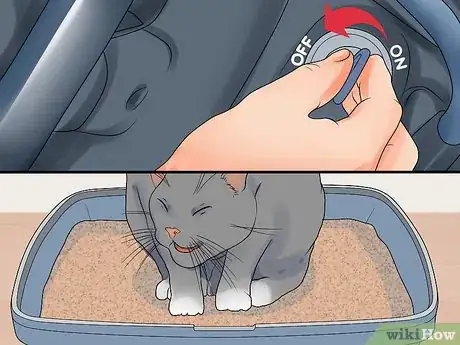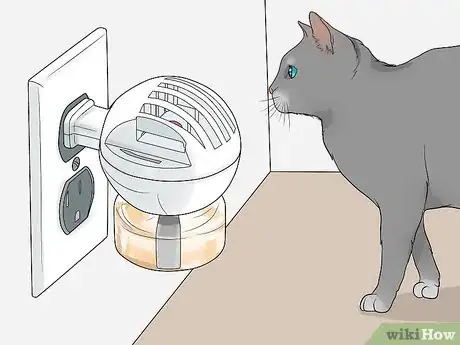This article was co-authored by Brian Bourquin, DVM. Brian Bourquin, better known as “Dr. B” to his clients, is a Veterinarian and the Owner of Boston Veterinary Clinic, a pet health care and veterinary clinic with three locations, South End/Bay Village, the Seaport, and Brookline, Massachusetts. Boston Veterinary Clinic specializes in primary veterinary care, including wellness and preventative care, sick and emergency care, soft-tissue surgery, dentistry. The clinic also provides specialty services in behavior, nutrition, and alternative pain management therapies using acupuncture, and therapeutic laser treatments. Boston Veterinary Clinic is an AAHA (American Animal Hospital Association) accredited hospital and Boston’s first Fear Free Certified Clinic. Brian has over 19 years of veterinary experience and earned his Doctor of Veterinary Medicine from Cornell University.
There are 9 references cited in this article, which can be found at the bottom of the page.
This article has been viewed 30,841 times.
Cats love predictable routines, so moving can be upsetting for your feline friend. Fortunately, if you’re planning a move, there are ways you can make the process as stress-free as possible. For starters, give yourself plenty of time to pack so your pet has time to adjust. If you don’t board your cat on moving day, keep it in a closed room while you load boxes and furniture. Finally, introduce your pet to your new home gradually, and let it explore its turf 1 room at a time.
Steps
Making Packing Less Stressful
-
1Bring out moving boxes early so your cat can get used to them. Leave empty moving boxes around your house several weeks before moving day. Hold off on filling them for a few days so your cat has a chance to investigate.[1]
- Your cat may even enjoy playing in the empty boxes. It’ll be less anxious about packing if it sees the boxes as fun and non-threatening.[2]
-
2Pack your things gradually instead of waiting until the last minute. Take things slowly, as packing everything suddenly will stress out your cat. Pack 1 room at a time so your pet can maintain a sense of security.[3]
- Cats like predictability and aren’t big fans of sudden change. Your pet will be much happier if you pack gradually and let it stick to its normal routines as much as possible.
Advertisement -
3Keep your cat in a familiar room while you pack boxes. Your cat might get freaked out if it’s around when you’re filling up boxes. When you’re busy packing, move your cat into a closed room with its food, water, toys, bed, and litter box. A bedroom or spare room where your cat likes to nap or play is a good option.[4]
- Additionally, you’ll be packing hazardous or delicate objects at some point in the process. Keeping your cat in a closed room will prevent it from getting into trouble.
- Before letting your cat out of its room, make sure any boxes you stack are secure, and look out for other packing-related hazards. Try to keep your cat away from packed boxes to prevent it from damaging them or getting hurt.
- If possible, pack up your cat's room last so it has a calm, safe space throughout most of the packing process. When you need to pack up its safe room, keep your cat and its necessities in another comfortable, secure area.
-
4Try to stick to your pet’s routines as much as possible.[5] Do your best to make things as stable as possible for your cat. For instance, maintain its feeding schedule if you typically offer meals at certain times of the day. Packing may take up a lot of your time, but try to take regular breaks to play and cuddle with your cat as you normally would.[6]
Safety first: If your cat is used to going outside, that's one part of its routine you'll need to change. Keep it inside at all times during the packing process. It might run away if all the commotion of packing makes it too anxious.[7]
Keeping Your Pet Safe on Moving Day
-
1Train your cat to stay in a crate or carrier. If you haven’t already, get your cat accustomed to spending time in a crate or carrier to prepare it for its trip. Start by feeding it meals and treats inside the enclosure with the door open. Then keep it in the crate or carrier with the door closed for gradually longer periods of time.[8]
- The crate or carrier should be just large enough that your cat has room to turn around.
- Always offer your cat treats and praise when you put it in the enclosure. Do your best to make the training process as stress-free as possible.
- After training your cat to spend time in the carrier, practice taking short drives with it to get it used to traveling.
-
2Keep your cat in a quiet room while you load the moving truck. Place your cat’s water, toys, bed, and litter box in the room. Close the door, and leave a note on the door so no one accidentally lets your cat escape.[9]
- If you’ll be traveling with your cat later that day, feed it a light meal in the morning to help prevent it from getting carsick.
Variation: To keep your cat away from the stress of moving day altogether, consider boarding it. Ask the vet or look online to find a reputable boarding cattery, or have a friend watch your cat at their home.[10]
-
3Transport your cat in its carrier. Keep your cat in its carrier when you drive it to your new home. Make sure the carrier is well-ventilated, maintain a comfortable temperature, and secure the carrier so it won’t slide when you turn or come to a sudden stop.[11]
- To help keep your pet calm, place a towel, pillow, or soft toy with familiar scents in the carrier. Offer reassurance by occasionally talking to it in a high-pitched, soothing voice.
- Ask your vet for other recommendations for keeping your cat calm during travel. They might recommend a calming dietary supplement, such as Zylkene.
- It’s unsafe to drive with a cat outside of its carrier, especially if your vehicle is packed with your belongings. Your cat could get injured or it may distract the vehicle’s driver.
-
4Take periodic breaks if you’re driving a long distance. If you’re traveling more than an hour or so, pack water, a portable litter box, litter, a scoop, disposable bags, and a cat harness. Stop every 2 or 3 hours to let your cat stretch, take a drink, and use the litter box.[12]
- If there’s room in your vehicle, set up the litter box on the floor and see if your cat will do its business. If there’s no room, set up the litter box on the ground outside of the vehicle. Just don’t let your cat out of the vehicle unless it’s harnessed.
- It might not be comfortable enough to use the litter box during a break en route. If that’s the case, set up the litter box as soon as you get to your destination. Place it in a closed off room and give your cat some privacy to encourage it to go.
- If you need to stay in a hotel overnight, search in advance for pet-friendly accommodations on your route.[13]
Introducing Your Cat to Its New Home
-
1Set up a secure room with your cat’s belongings. Place your cat’s food, water, bed, litter box, and other essentials in a quiet, secure room in the new house. Then bring the carrier to the room and let out your cat. Keep your pet in the room for a few days, or until it seems comfortable with its new surroundings.[14]
- A spare room that doesn’t need to be set up right away is a good choice. That way, your cat can get acclimated without furniture and boxes being shuffled around it.
- Spray the room you select with a calming pheromone spray, such as Feliway. These sprays have a smell that cats find calming and reassuring.
- When you unload boxes and furniture, keep a sign on the door so no one accidentally lets out your cat.
- Keep hiding spots, climbing perches, and scratching posts in the room to enrich your pet’s environment. Empty boxes can be entertaining, so try placing some in the room as you unpack.
-
2Calm your cat with a pheromone spray or diffuser. Ask your cat's vet if they provide artificial pheromones, or look for products online and at pet stores. Set up a diffuser or spray the product in your cat's room to help it feel more secure with its new surroundings.[15]
- Artificial pheromones mimic the scents cats use to mark their territory and are commonly used to help reduce stress in cats.
- You can also use a pheromone spray or diffuser to calm your cat while you pack or when you're on the road.
-
3Use your cat's scent to make its new home feel more familiar. Before letting your cat explore your new home, gently rub a clean cloth against its face. Dab the cloth around the house to help your cat feel at home. Try to think like a cat, and dab the cloth in spots where your pet would rub its face and body.[16]
- You’ve probably noticed your cat loves to rub its face against everything from sofas to your shin. Cats do this to mark their territory, and marking spots with the cloth can help your cat understand that your new house is its turf.
- Spraying artificial pheromones around the house can also help your cat feel more at home.
-
4Let your cat explore your its new home 1 room at a time. At first, your cat may hide and seem insecure. Once it stops hiding, plays, purrs, and otherwise seems confident, let it out of its room so it can explore other parts of the house. Giving it free rein over the entire house right away can stress it out, so expose it to its new surroundings gradually.[17]
- Offer treats and toys as your cat explores to help keep it calm.[18] Let it explore a room or section of your house for 10 or 15 minutes, then take it back to its safe room. It may take a couple of days to get your cat used to your entire house.
- Make sure the areas you let your cat explore are free of stacked boxes, breakable objects, and other hazards. Don’t, for example, let your cat in the kitchen if glasses, plates, forks, and knives cover all of the counters.
-
5Make sure your cat has adjusted before letting it go outside. If you plan on letting your cat spend time outside, give it about a month to become accustomed to its new home first. Let it out for the first time just before you feed it a meal. Get its food and favorite treats ready, open the door, and let your cat briefly explore your enclosed yard.[19]
- After 5 to 10 minutes, call it back inside and offer the food. If its normal meal doesn’t grab its interest, offer a strong-smelling treat, such as tuna.
- Let your cat out for gradually longer supervised trips outside once a day. Leave it unattended only when it appears confident outside and reliably returns when called.
Tip: Before letting your cat outside, sprinkle some of its used litter around the perimeter of your yard. It might seem gross, but it’ll teach your cat the boundaries of its territory and help prevent it from getting lost.[20]
Expert Q&A
Did you know you can get expert answers for this article?
Unlock expert answers by supporting wikiHow
-
QuestionHow can I tell if my cat is stressed?
 Brian Bourquin, DVMBrian Bourquin, better known as “Dr. B” to his clients, is a Veterinarian and the Owner of Boston Veterinary Clinic, a pet health care and veterinary clinic with three locations, South End/Bay Village, the Seaport, and Brookline, Massachusetts. Boston Veterinary Clinic specializes in primary veterinary care, including wellness and preventative care, sick and emergency care, soft-tissue surgery, dentistry. The clinic also provides specialty services in behavior, nutrition, and alternative pain management therapies using acupuncture, and therapeutic laser treatments. Boston Veterinary Clinic is an AAHA (American Animal Hospital Association) accredited hospital and Boston’s first Fear Free Certified Clinic. Brian has over 19 years of veterinary experience and earned his Doctor of Veterinary Medicine from Cornell University.
Brian Bourquin, DVMBrian Bourquin, better known as “Dr. B” to his clients, is a Veterinarian and the Owner of Boston Veterinary Clinic, a pet health care and veterinary clinic with three locations, South End/Bay Village, the Seaport, and Brookline, Massachusetts. Boston Veterinary Clinic specializes in primary veterinary care, including wellness and preventative care, sick and emergency care, soft-tissue surgery, dentistry. The clinic also provides specialty services in behavior, nutrition, and alternative pain management therapies using acupuncture, and therapeutic laser treatments. Boston Veterinary Clinic is an AAHA (American Animal Hospital Association) accredited hospital and Boston’s first Fear Free Certified Clinic. Brian has over 19 years of veterinary experience and earned his Doctor of Veterinary Medicine from Cornell University.
Veterinarian
Warnings
- Sedate your cat only as a last resort, and do so with the guidance of a vet. Keep in mind many airlines do not transport pets that have been sedated.[24]⧼thumbs_response⧽
References
- ↑ https://www.aspca.org/pet-care/general-pet-care/moving-your-pet
- ↑ https://www.catbehaviorassociates.com/moving-to-a-new-home-with-your-cat/
- ↑ https://www.nytimes.com/2017/08/22/smarter-living/moving-with-pets-tips.html
- ↑ https://www.aspca.org/pet-care/general-pet-care/moving-your-pet
- ↑ Brian Bourquin, DVM. Veterinarian. Expert Interview. 20 December 2019.
- ↑ https://www.nytimes.com/2017/08/22/smarter-living/moving-with-pets-tips.html
- ↑ https://www.catbehaviorassociates.com/moving-to-a-new-home-with-your-cat/
- ↑ http://www.vetstreet.com/our-pet-experts/make-moving-less-stressful-for-your-cat
- ↑ https://www.bluecross.org.uk/pet-advice/moving-house-and-travelling-cats
- ↑ https://www.cats.org.uk/uploads/documents/cat-care-leaflets-2013/EG03_Moving_house_JUN14.pdf
- ↑ https://www.aspca.org/pet-care/general-pet-care/travel-safety-tips
- ↑ https://www.aspca.org/pet-care/general-pet-care/travel-safety-tips
- ↑ https://www.nytimes.com/2017/08/22/smarter-living/moving-with-pets-tips.html
- ↑ https://www.cats.org.uk/uploads/documents/cat-care-leaflets-2013/EG03_Moving_house_JUN14.pdf
- ↑ https://www.cats.org.uk/uploads/documents/cat-care-leaflets-2013/EG03_Moving_house_JUN14.pdf
- ↑ https://www.bluecross.org.uk/pet-advice/moving-house-and-travelling-cats
- ↑ http://www.vetstreet.com/our-pet-experts/make-moving-less-stressful-for-your-cat
- ↑ Brian Bourquin, DVM. Veterinarian. Expert Interview. 20 December 2019.
- ↑ https://www.cats.org.uk/uploads/documents/cat-care-leaflets-2013/EG03_Moving_house_JUN14.pdf
- ↑ https://www.bluecross.org.uk/pet-advice/moving-house-and-travelling-cats
- ↑ https://www.bluecross.org.uk/pet-advice/moving-house-and-travelling-cats
- ↑ https://www.cats.org.uk/uploads/documents/cat-care-leaflets-2013/EG03_Moving_house_JUN14.pdf
- ↑ https://www.humanesociety.org/resources/travel-safely-your-pet-car-airplane-ship-or-train
- ↑ https://www.nytimes.com/2017/08/22/smarter-living/moving-with-pets-tips.html
About This Article
To keep a cat calm during a move, keep it in a secure room at your new home with all of its belongings for a few days so it has time to adjust. You might want to use a cat pheromone diffuser or spray in the room, which will calm your cat and reduce any stress it's feeling. Then, after a few days, take something with your cat's scent on it and dab it on surfaces around your new home to make it less scary for your cat. When you're finished, let your cat explore the house 1 room at a time. To learn how to keep your cat safe on moving day, scroll down!






















-Step-19.webp)

















































